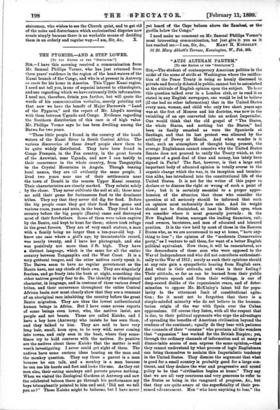THE PYGMIES,—AND A STEP LOWER.
[To TIIC EDITOR OF THE "SPECTATOR."] SIR,—I have this morning received a communication from Mr. Samuel Phillips Verner, who has just returned from three years' residence in the region of the head-waters of the Kasai branch of the Congo, and who is at present in Antwerp en route for his home in America. This Upper Kasai region, I need not tell you, is one of especial interest to ethnologists, and one regarding which we have extremely little information. I need not, therefore, detain you further, but will quote the words of his communication verbatim, merely pointing out that now we have the benefit of Major Burrows's " Land of the Pygmies," and the report of Mr. Lloyd's meeting with them between Uganda and Congo. Evidence regarding the Southern distribution of this race is of high value• Mr. Phillips Verner says he has been dwelling among the Batwa for two years.
"These little people I found in the country of the head- waters of the Kasai River in South Central Africa. The various discoveries of these dwarf people show them to be quite widely distributed. They have been found in Congo Francais, in the Fan country, in the great forests of the Aruwimi, near Uganda, and now I can testify to their occurrence in the whole country, from Tanganyika to the Crystal Mountains in Angola. Though bearing local names, they are all evidently the same people. I lived two years near one of their settlements near the town of Dombi in the remote Upper Kasai country. Their characteristics are clearly marked. They subsist solely by the chase. They never cultivate the soil at all; those near me sold their game for farinaceous food to the dominant tribes. They say that they never did dig for food. Before the big people came they got their food from game and various roots, yams and nuts, in the bush. They lived in the country before the big people (Bantu) came and destroyed most of their forefathers. Some of them were taken captive by the Bantu, and kept to hunt for them; others took refuge in the great forests. They are of very small stature, a man with a family being no larger than a ten-year-old boy. I knew one case where a girl's age, by incontestable record, was nearly twenty, and I have her photograph, and she was positively not more than 3 ft. high. They have a distinct language, which is the same for all the entire country between Tanganyika and the West Coast. It is a very guttural tongue, and the other natives rarely speak it. The Batwa seem to have no regular government as the Bantu have, nor any chiefs of their own. They are singularly fearless, and go freely into the bash at night, something the other natives greatly fear to do. The identity in ethnological character, in language, and in customs of these various dwarf tribes, and their occurrence throughout the entire Central African basin now must clearly show that they are a remnant of an aboriginal race inhabiting the country before the great Bantu migration. They are thus the lowest authenticated human beings in Africa. But I have come across reports of some beings even lower, who, the natives insist, are people and not beasts. These are called Kaieke, and I have a boy here (Antwerp) who insists he has seen them, and they talked to him. They are said to have very long hair, small, keen eyes, to be very wild, never coming into towns, and only seen in the bush, where they some- times try to hold converse with the natives. So positive are the natives about these Kaieke that the matter is well worth investigating. I never could get sight of them. The natives have some curious ideas bearing on the man and the monkey question. They say there a parrot is a man because he can talk, and a monkey is a man because he can use his hands and feet and looks like one. As they eat men also, their eating monkeys and parrots proves nothing.
When we visited the Zoological Gardens at Antwerp and saw the celebrated baboon there go through his performance my boys triumphantly pointed to him and said, 'Did not we tell you so ? ' These Kaieke might be baboons, but I have never
yet heard of the Cape baboon above the Zambesi, or the gorilla below the Congo."
I need make no comment on Mr. Samuel Phillips Verner's most interesting communication, but just give it you as it






































 Previous page
Previous page